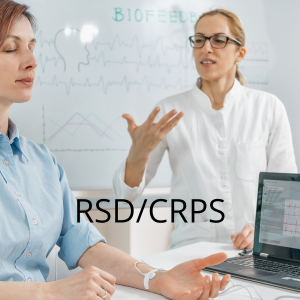After a seemingly minor injury like an ankle sprain or a broken wrist, you expect your pain to diminish over time as the ligaments, muscles and bones heal. In some cases, however, the pain doesn’t go away as your injury heals. Instead, it gets progressively worse, to the point where you cannot use the affected limb without excruciating pain. Medications may be out of the question and other treatments may not be covered by your insurance provider. So what’s left if you’re to obtain any kind of relief from your pain?
What is Biofeedback?
 When you are too cold, you put on a sweater or turn the heat higher in your home. You are responding to stimuli that tells you you’re cold. This, in a simplified form, is biofeedback. In the medical office, doctors train their patients to learn to influence certain body functions to control a medical condition.
When you are too cold, you put on a sweater or turn the heat higher in your home. You are responding to stimuli that tells you you’re cold. This, in a simplified form, is biofeedback. In the medical office, doctors train their patients to learn to influence certain body functions to control a medical condition.
Using sensors that look like the EKG leads that monitor your heart rate, doctors measure your skin temperature, heart rate, brain waves and the muscle tension in some groups of muscles in your body. Your body’s responses are then measured and displayed, either as a sound or a visual. Once your doctor gets a baseline of your neurofeedback, he begins to teach you how to “train” your body to control these functions. As you repeat the sessions, you slowly begin learning yow to exert control over these functions – at some point, you will do so without using the sensors and instruments.
Sound crazy? It’s not – think of “mind over matter.” In your case, it’s “mind over pain.”
The Biofeedback Process
As you begin your biofeedback training, you lie back in what looks like a dentist’s chair and the doctor hooks you up to several instruments that measure your body’s temperature and muscle tension. Once you are hooked up to the sensors and the doctor or a technician gathers your baseline neurofeedback data. Once this is done, the doctor begins to teach you how to use your mind to control your pain, bringing it down to a manageable level.
She does this by teaching you breathing and imaging techniques. She may also have you try to move your affected limb, using animated images on a computer screen.
Part of your biofeedback training involves learning how to influence the temperature in your fingers. She tells you to think about raising the level of blood flow to your fingers.
How?
How do you raise the temperature of a body part? It is possible to influence body temperature by focusing on it – the doctor gives instructions to “focus inward” or “look at your pain differently.” For instance, if you are being asked to increase the temperature of your right hand, imagine sitting in a sun-filled room while the sun is hitting your hand. Tell yourself “My hand feels warm . . . it is getting heavier and warmer.”
Based on your own CRPS or RSD symptoms, your doctors will help you write an evocative and effective script that helps you to easily call up the images you need to control your pain. You receive an audiotape of the script with small sensory thermometers that you use as you practice your new biofeedback sessions on your own at home. Over time, as you practice your imaging skills every day, you will become more and more adept at focusing on your pain, its intensity level and how to “dial the pain down” as you use biofeedback.
To view a burning sensation differently, for instance, imagine that you are standing in a room with a fireplace. You feel the warmth from the fireplace, but it’s not overwhelming. After you use this technique, you learn to use it away from the hospital whenever your pain becomes intense.
Researchers have begun using “functional magnetic resonance imaging” to see pain as it happens in the brain. Volunteers agreed to have heated probes placed against their arms. As this was happening, real-time fMRI scans showed the pain experience in their brains as red and yellow blobs surrounded by gray. The volunteers learned how to shrink the blobs – and their perception of their pain – by concentrating on the images they were seeing.
Members of your Biofeedback Team
While you and your doctor are two of the most important team members, you need others on this team as well. Other specialists who care for the body area that’s impacted by your RSD or CRPS (cardiologist, neurologist or even your therapist). When you learn biofeedback, you are learning a new way of perceiving and treating your pain – thus, you are likely to begin working with a cognitive-behavioral therapist. This person should also be a part of your pain-treatment team.
Will This Technique Work For You?
The answer to this question depends on you. You and your doctor have to think about several factors, such as how you perceive the intensity of your pain and how you self-report that pain, not only to your doctor, but to yourself. The intensity scale isn’t always reliable – what is intolerable today may be tolerable tomorrow. How you felt yesterday and how you feel today are variables that affect your pain experiences day to day. Other factors that affect your daily pain experience include your feeling of well-being, your feeling of sleepiness and your anxiety levels.
If you have been prescribed high dosages of opioid medications for a long time, your sensitivity to pain actually increases, probably due to your body’s reactions to the effects of the medication – to block pain.
Benefits of Biofeedback
Biofeedback reduces the amount of medications you must take to help you manage your level of pain. While you may not be able to totally wean yourself off medication, you might, under medical supervision, be able to decrease your dosage. This pain management technique has nearly no side effects and it is noninvasive. Depending on how well you learn, it may also have positive long-term effects.
References: http://www.med.nyu.edu/content?ChunkIID=13550 – Understanding Biofeedback; http://stanmed.stanford.edu/2005fall/pain.html – Pain’s Stronghold: It’s All in Your Head

One thought on “CRPS, RSD and Biofeedback – It’s Mind over Matter”
Wow, fantastic blog layout! How long have you ever been running a blog for? you make running a blog glance easy. The whole look of your site is wonderful, let alone the content!